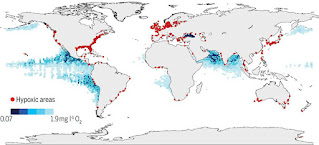A chart of ancient oceanic' dead zones' can prognosticate unborn locales and impacts
Experimenters have created a chart of ocean dead zones that was during the Pliocene time, when Earth's climate was 2 to 3 degrees warmer than it's now.
This work provides a regard into the locales and implicit impacts of unborn low- oxygen zones in a warm Earth's abysses.
Oxygen minimal zones, or OMZs, are areas in the ocean where oxygen situations in the midwater( 100 to 1000 measures above the face) are too low to support marine life. These dead zones play an important part in the overall health of the ocean. OMZs are important for geochemical cycling in the ocean, says Katherine Davis, assistant professor of ocean, earth and atmospheric lores at North Carolina State University and corresponding author of the exploration.
They do in areas where there's no access to sun and atmospheric oxygen. They're important motorists of nutrient cycles because their locales mandate where carbon and nitrogen( an essential nutrient for all life on Earth) are available in the ocean. Being suitable to prognosticate the position of OMZs is important not only for understanding nutrient cycling, but also because of their goods on marine life.
Oceanic dead zones limit the range of creatures to the shallow face ocean, where oxygen is most abundant. Davis and her associates wanted to determine how a warmer climate might affect OMZs in the future. So they looked to the Pliocene time,(5.3 to2.6 million times agone) when Earth's atmospheric CO2 situations were close to what they're now.

The Pliocene was the last time we had a stable, warm climate encyclopedically, and the average global temperature was 2 C to 3 C warmer than it's now, which scientists prognosticate will be within 100 times.
Davis said. To determine where the Pliocene OMZs were, the experimenters used bitsy reactionary plankton called foraminifera. Foraminifera are unicellular organisms about the size of a large grain of beach. They form hard, ca carbonate shells that can remain in marine sediments.
One species in particular, Globorothaloides hexagonalus, is set up only in low oxygen zones. By digging through databases of Pliocene sediments to identify that species, the platoon was suitable to collude Pliocene OMZs. They overlaid their chart on a computer model of Pliocene oxygen situations and set up that the two agreed with each other.
The OMZ chart showed that during the Pliocene, low- oxygen waters were wide in the Atlantic Ocean, particularly in the North Atlantic. The North Pacific, on the other hand, has lower oxygen-poor areas. This is the first global spatial reconstruction of once oxygen minimum zones, Davis said. And it's harmonious with what we are formerly seeing in terms of lower oxygen situations in the Atlantic.
Warmer water contains lower oxygen. This dead zone chart from the Pliocene gives us a regard of what the Atlantic will look like 100 times from now. What does the unborn mean for the Atlantic with so little oxygen? According to Davis, this could have a major impact on how fisheries and marine species are managed from carbon storehouse and nutrient cycling in the ocean.
OMZs act as a substrate for marine creatures that access the face, Davis said. So fishers may suddenly see a lot of fish, but that does not mean there are actually further than normal, they are just being forced into a lower area. The impacts of OMZs should be considered in fisheries operation.
The population We can also see subtle but far- reaching changes in the quantities of nutrients available to life in those face waters, as well as CO2 stored by the ocean. The exploration appears in Nature Dispatches and was supported by the National Science Foundation( entitlement OCE- 1851589). Davis began the exploration while a postdoctoral experimenter at Yale.
Postdoctoral experimenter Elizabeth Siebert, Pincelli Hull Associate Professor of Geology and Geophysics, a formerPh.D. pupil Peter Jacobs and Natalie Burles, associate professor of atmospheric, oceanic and earth lores, also contributed to the work. Siebert and Hull are at Yale, Burles is at George Mason University, and Jacobs, formerly of George Mason, is at NASA. Accoutrements handed by North Carolina State University.
Original written by Tracy Peek.
Visit Official Home Page




.jpg)

0 Comments